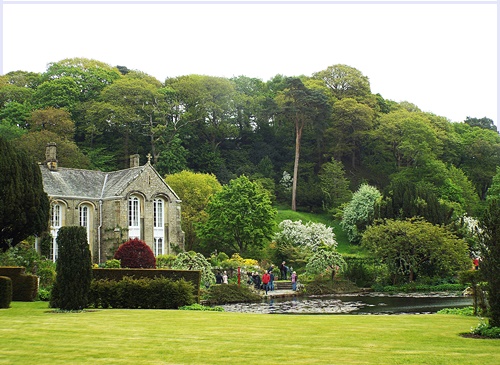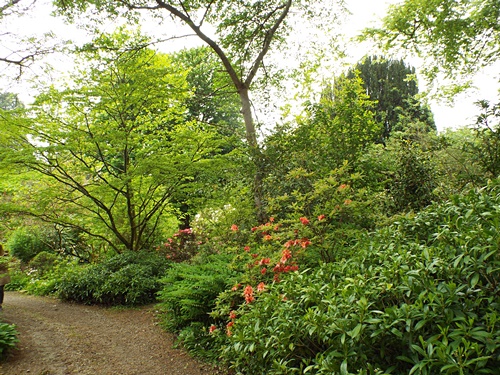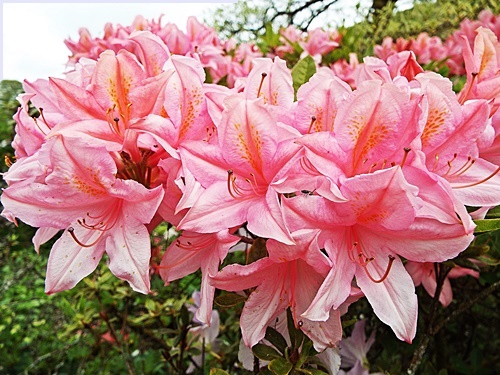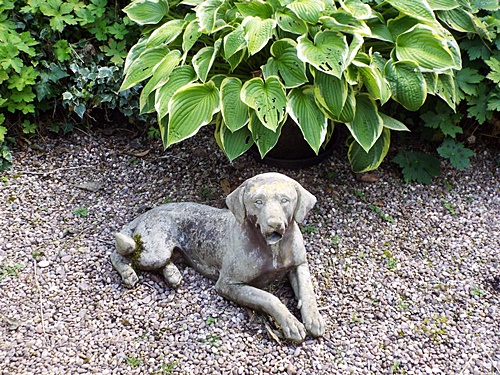Category: Gardens
Granby Winter Garden and a bit of Toxteth history
Having been impressed with the amount of street art I found on my first day out in Liverpool last month I went back to the city just a few days later, however my initial purpose this time was to visit Granby Winter Garden, something which I’d come across on the internet a while ago and more recently on another blog.
The inner-city area of Toxteth was originally part of a royal park and was predominantly rural until being developed during the 18th and 19th centuries into a residential area to accommodate the increasing working-class community following the Industrial Revolution. Immigrants to Toxteth since the turn of the 19th century included thousands of Irish Catholic and Welsh people, many Africans and Chinese, and since the end of World War ll the area has been a popular destination for Commonwealth immigrants arriving in Liverpool from the Caribbean and the Indian subcontinent, resulting over the years in a large community of black and mixed-race residents.
During the 1970s and early 1980s Britain’s economic decline hit Toxteth hard, leaving the area with some of the highest unemployment rates in the country and crime increasing as a result. In 1981 long-standing tensions between local black communities and the Merseyside police force, which had a bad reputation for disproportionately stopping and searching young black men in the area, boiled over on July 3rd after the heavy-handed arrest of young Jamaican-born photography student Leroy Cooper near Granby Street. This resulted in a disturbance in which petrol bombs and bricks were thrown at police, with the disturbance itself escalating into nine days of rioting in the streets of the Granby Triangle during which rioters used scaffolding poles to attack police and stolen milk floats were set on fire and aimed at them.
Police reinforcements were drafted in from several other forces across the country to try to control the unrest and CS gas was used against the rioters, the first time it had been deployed in the UK outside of Northern Ireland. Over the course of the nine days 100 cars were damaged and destroyed, shops were extensively looted, 500 arrests were made, nearly 1,000 police officers were injured – 300 in one night alone – and at least 70 buildings were so severely damaged by fire that they later had to be demolished.
A second wave of rioting began on July 27th when several cars were set alight and missiles were thrown at police officers with 26 being injured, however this time the police responded by driving vans and Land Rovers at speed into the crowds to disperse them. This was a tactic which had been developed by the Royal Ulster Constabulary in Northern Ireland and used successfully by Greater Manchester Police in the Moss Side riots – it worked in Toxteth too and the riot was ended within 24 hours but not without tragedy. A 23-year old local man, David Moore, was struck by a police vehicle clearing the crowds and later died from his injuries; two police officers were charged with his manslaughter but were cleared in April 1982.
After spending some time on remand and in borstal Leroy Cooper, whose arrest sparked the riots, returned to the Liverpool area and signed up for a 12-week photography course with Open Eye Gallery after which he dedicated his life to photographing the city and its people, amassing around 200,000 images taken over an almost 40-year period. He died in March 2023 at the age of only 62 – a display of his work, Liverpool Through The Lens, is currently on show at the Museum of Liverpool and will remain there until March 31st 2024.
Prior to the 1981 riots the standard of housing in both the public and private sector had already been in a steady decline and following the riots the Granby area became increasingly bleak as more shops went out of business and empty boarded up houses became prevalent, leading to an eventual programme of widespread demolition and rebuilding. In 1993 the Granby Residents Association was established to try to halt the demolition of properties in the remaining streets and despite a further loss of houses leading to empty patches of land the GRA campaigned throughout the 90s to save four streets in the neighbourhood.
In 2002 the Housing Market Renewal Initiative was implemented by the government and Liverpool council identified the four streets in Granby as a potential site for demolition and rebuilding but with the support of SAVE Britain’s Heritage the Granby Residents Association campaigned against the proposals. In 2010 the Residents Association was unfortunately disbanded, leaving the four streets more vulnerable to the HMR Initiative, but due to the government cutting the funding for the Initiative the proposals for Granby were halted. Despite being left in demolition limbo the residents decided to brighten up the neighbourhood by painting the facades of boarded and bricked up properties and growing plants around them, gradually extending the greenery to the small front gardens and pavements along the length of the streets, and a community market was set up during the summer months which later became the monthly Granby Street Market.
When the council put the four streets out to tender a new campaign group was formed and at the end of 2011 the residents formally constituted themselves as the Granby Four Streets Community Land Trust. Shortly after the Trust’s establishment the council tender was won by a private contractor but when six months had passed with hardly any progress in redeveloping the streets the council terminated the contract. The Trust then contacted the council to discuss other possibilities including ending plans for redevelopment in favour of funding for the renovation and ownership of derelict properties.
With the support of SAVE the Trust worked with social investors Steinbeck Studios and Liverpool Mutual Homes to propose a plan for renovation under their own control and by 2014 the council had transferred 10 properties on Cairns Street over to the Trust with the help of grant funding from a number of housing and community initiatives. Through Steinbeck Studios London-based architecture design team Assemble were invited to design and develop the homes for affordable rent or ownership subject to certain conditions and Granby Workshop, a ceramics studio making fixtures and fittings for homes, was also established nearby. In 2015 Assemble won the Turner Prize for the design of the homes, becoming the youngest ‘non-artists’ to win an award typically given to visual artists, and by 2019 five of the Trust-owned homes had been sold while the other five had new tenants.
When it came to renovating other Cairns Street houses two of them were in poorer condition than the rest and it would have cost too much to turn them back into habitable homes, however enough funding was raised to knock the two houses together, put a glass roof on them, and create an indoor garden and meeting venue to be used for community get-togethers, events and activities. The indoor garden was designed and planted by Liverpool-based gardener and beekeeper Andrea Ku and Granby Winter Garden was opened in March 2019.
Cairns Street is situated towards the far end of Princes Avenue and just over a one-and-a-half mile walk from Lime Street station. Princes Avenue itself runs parallel to Princes Road with the two being separated by a long, wide and very attractive tree-lined pedestrian boulevard – it all looked very lovely but I was too intent on finding Cairns Street to think about taking any photos. In comparison the two streets are vastly different – Princes Avenue with its long rows of attractive large 3-storey double-fronted red brick Victorian villas with decent sized gardens then running off at an angle Cairns Street with its Victorian properties of a very different kind, two up/two down terraced houses with tiny little garden spaces at the front just about big enough for three or four planters but too small to really be called gardens.
Cairns Street is bisected by Granby Street and looking up and down the road it was obvious that this was, and still is to some extent, a bit of a run down area in need of some attention, however I was quite pleasantly surprised by Cairns Street itself. The Winter Garden is situated about halfway along the tree-lined second block and though five houses at the beginning of the row are still bricked up they don’t make the street look unattractive. With ivy growing up the walls and over the painted bricked up doors and windows and planters of flowers in the tiny garden spaces they look more like a living art installation than empty properties.
With the Winter Garden having once been two separate houses it had two front doors next to each other – both were open and not really knowing what to expect I went tentatively in through the right hand one and was greeted warmly by Hazel Tilley, one of the founder members and vice-chair of the Community Land Trust, who offered me coffee and biscuits, told me about the development of the street and the Winter Garden, then left me to wander round and take as many photos as I wanted.

Renovated with exposed brickwork and some of the original features preserved there was no upper floor in the right hand side and with tall plants and the glass roof it was almost like being in a small Victorian palm house, while the left side of the building housed a project space/common room and a small community kitchen.
At the rear of the right hand side stairs led up to a small balcony and a light but cosy double bedroom occupying about two thirds of the space above the left side of the building and with a stable door and Juliet balcony looking out over the room below. When not being used by an ‘artist in residence’ the room is rented out via Airbnb to help towards the running costs of the building.
Back down the stairs a short corridor led to a spacious modern bathroom with shower, loo, basin and all disabled facilities, with floor to ceiling tiles specially made in the Granby Workshop at the end of the street. Out in the back yard was a potting shed and a specially constructed rainwater pool brightly tiled with more of Granby Workshop’s creations then beyond the back gate was the hidden oasis which I’d been looking forward to seeing.
Running the full length of the block is a narrow alleyway sandwiched between the back of the Cairns Street houses and the back of the houses behind. Once a rubbish dump plagued with rats it’s been transformed into a green and colourful secret community garden filled with dozens of pots of flowers, fruit and vegetable plants. Originally started in 2017 by green fingered Elizabeth Robinson-Ramos and her husband Paul, whose back gate opens out into the alley, several neighbours have joined in to help care for all the plants while others have donated various items to use as plant stands and flower pots and Paul has used recycled discarded items as quirky bits of decoration. The alleyway is gated at each end and only accessible through the homes which back onto it so I felt quite privileged to be given access through the Winter Garden so I could wander at leisure and take some photos.










Back out through the Winter Garden and just for curiosity I took a walk to the far end of the tree-lined street. With the exception of the five houses at the other end every single home was occupied – with colourful doors, well kept frontages and plants and flowers everywhere it was a street with a great sense of community and pride and I headed off into the next part of my day with much admiration for the residents and all they have achieved over the years.
Spring comes to Gresgarth Hall
What a difference a month makes! After a rather disappointing visit to Gresgarth Hall in April my visit there last Sunday showed that the garden had burst into life during the previous four weeks and it was all starting to look rather lovely. The same couldn’t be said for the weather though – a check on the live webcam for that area before I left home showed sunshine but by the time I got there just over an hour later it was all rather dull. The sun did reappear briefly a couple of times but not enough to make a difference and without any actual grey clouds I was left with the one thing I hate when taking photos – a featureless white sky.
Exploring the hillside on the south of the river, which I hadn’t done on previous visits, I was pleasantly surprised at what I found. A mixture of grass paths and gravels tracks meandered through the trees and I came across some features which I didn’t expect to see – a cute and quirky stone building nestling among the greenery, a rustic bridge across the river, and a stone folly set back off one of the paths. A set of recently built steps took me down to the bridge so I crossed over and headed along the opposite hillside and back down to the main part of the garden.
The sweet smell of hawthorn perfumed the air in several places, rhododendrons in a variety of colours were dotted here and there, many still in bud, and wild garlic (which I can’t stand the smell of) grew in abundance beneath the trees in a shady corner.
At the stall by the entrance gate a cute little dog mooched quietly about round the table; it was called Kipper and belonged to one of the ladies on the stall. It was rather a sweet little thing and I couldn’t resist taking a couple of photos of it before I left.
Wandering round the garden for a couple of hours and discovering things I hadn’t seen before had been very enjoyable, it was just a shame that the weather couldn’t have been brighter. Blue sky and sunshine would have made so much difference to the photos so I’m keeping my fingers metaphorically crossed that’s what I’ll get if I go back next month.
Gresgarth Hall garden – April 2023
Lovely sunny weather on Easter Sunday prompted me to make my first visit of this year to Gresgarth Hall garden. Now I’ve said more than once over the years that I have absolutely no interest in gardening and other than the obvious ones I have no idea of plant/flower/tree/shrub names, nor do I know where they grow and when, so having seen this garden in full bloom twice last year maybe I was expecting too much when it’s still so early in the season.
The predominant colour seemed to be white, with trees full of white blossom dotted in many places around the garden, though an odd bit of colour did appear here and there. The most interesting thing in the very bare kitchen garden was an owl guarding one of the greenhouses while most of the flower beds in the main garden were very sparse, though the daffodils on the hillside were quite plentiful.
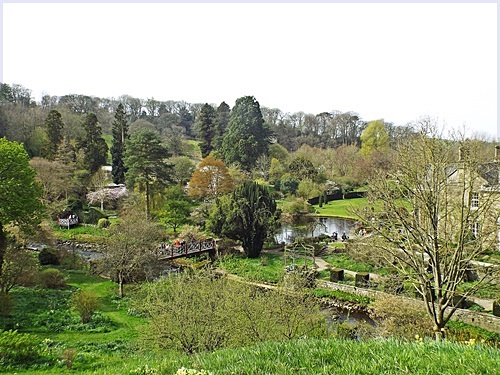
In the middle of one of the flower beds was a friendly looking almost life-size lion which I hadn’t seen before, while the two roaring lions at the edge of the lake were now completely visible as they weren’t surrounded by foliage, though they were so close to the water that I could only see their faces by viewing them from across the lake.
It was unfortunate that the sun and blue sky disappeared while I was walking round but in spite of the garden looking rather bare in many places I still got some reasonable photos. Another couple of months and the place should be blooming with more colour so it won’t be too long before I return.
Hornby Castle Gardens and a quick trip to Morecambe
Just a few days ago the dogs and I paid a visit to Hornby Castle Gardens during the snowdrop open weekend. I’d originally been undecided about going as (according to the website) with it being early in the season some of the snowdrops were only just getting going but this was the only weekend the gardens could open, however we hadn’t had a decent day out so far this year and the weather was promising so off we went.
If I thought that getting there soon after the 11am opening time would avoid what would later be a lot of visitors I was wrong, there was quite a queue to pay at the table set up just inside the main gates. With a history talk scheduled for 12 noon at the main house most people seemed to be heading up that way so I went in the opposite direction to where it might be a bit quieter, starting with the woodland walk.
Past the pond the path led me to the walled garden but with bare flower beds and nothing much growing anywhere there was very little to see so I went down to the riverside, walking along by the water then following a steep path up to the corner of the castle lawns. Across the front of the castle steep steps took me back down onto the main driveway and with nothing else to see I headed back to the main road and the car park.


Still only lunch time and with the rest of the afternoon ahead it was too early to think about going back home once I left Hornby Castle so I headed for Morecambe and an excellent filling lunch of home made steak pie, mash, veg and gravy in Rita’s Cafe on the promenade, followed by a mooch round the indoor Festival Market then a walk down to West End and back along the promenade as far as the Eric Morecambe statue before returning to the van and finally heading for home.
The daylight hours increasing slowly each day meant that I was back home before it started to go dark, with the dogs having slept all the way back. As far as days out go there had been nothing special about this one but it had been good to have a few hours away from my local area, and if dogs could talk I’m sure Snowy and Poppie would agree.
Autumn at Bridgewater Garden
Taking advantage of a sunny blue sky morning in mid October I set off just after 10am for a second visit to Bridgewater Garden. Now this place is only ten miles from home but as I approached my turn-off from the motorway the sun disappeared and the whole area became shrouded in a thick mist. It wasn’t looking good for my garden visit but as I’d already booked and paid online going back home wasn’t an option so I decided to have a wander round the gift shop and hope that the mist would soon clear and let the sun come through.

Eventually the sun started to cut through the mist and it lifted enough for me to venture out so I headed across Victoria Meadow, an area I hadn’t been to on my previous visit, and by the time I’d got to the far end the mist had almost gone. The path across the meadow took me into the woodland at the unrestored eastern end of Ellesmere Lake and among the trees I came across the remains of a small folly on what would once have been an island in the lake.
The path took me round the far side of the lake and along past what had once been a landscaped formal terraced garden in the heyday of Worsley New Hall, now looking rather unkempt and overgrown but awaiting development by the RHS. Past the Chinese Garden the main path led me to the Old Frameyard with its large new glasshouse and beds of oddly shaped hydrangeas and from there I made my way to what has now become my favourite part of the whole place, the Paradise Garden.




The walled garden itself isn’t a place to follow any sort of planned route as there are so many paths leading off other paths and so many different sections to see so I just wandered leisurely around from one area to another, even doubling back on myself a couple of times, until I decided I’d seen just about everything there was to see. As I made my way back to the Welcome Building my last shot was the clear view over Moon Bridge Water, looking vastly different to my very misty first shot of earlier on.







Although mid October showed that many of the flowers and shrubs in the walled garden had been past their best there was still a lot of colour around and the autumn hues here and there had added to it, making for a very enjoyable second visit. I probably won’t go there during the winter months but I’m already looking forward to making a third visit next spring and hopefully getting another batch of good photos.
Autumn at Gresgarth Hall
The second Sunday of this month saw me revisiting Gresgarth Hall garden near Caton village. Having been there for the first time in August and been very impressed I was curious to know what it would look like now the seasons had changed. Several parts of the garden had undergone some subtle but still obvious changes in the planting and the features and though the trees didn’t have as much autumn colour as I’d hoped – maybe it was still a little early in the month – there was still enough to make a difference.
Another difference was in the number of visitors – I arrived soon after 12 noon and though I’d noticed plenty of cars in the car park there didn’t seem to be too many people around the garden. In August there had been a lot of visitors and photography was often frustrating but with fewer visitors this time I was able to take my photos without having to wait for someone to move out of the way. And I make no apologies for the number of flower close-ups and shots of the lake and the house from different parts of the garden – this place is far too nice not to go mad with the camera.
Across the Chinese Bridge and away from the main part of the garden I took a wander along the hillside above the river and in various grassy clearings among the trees I came across a few quirky features. A large stone urn on a pedestal, a statue, something which could once have been a sundial, and there was even a gravestone for ”Leo, 2003-2019” who I presume was the family dog.
In one of the garden rooms the low level foliage had been trimmed back to make the swirly mosaics on the path look more prominent, a couple of pyramid shaped bushes had appeared since my previous visit and round a corner I came across a benign looking lion which I hadn’t seen before, while the two roaring lions by the lakeside were more easily visible.
At £12.50 the entrance fee for the garden isn’t exactly cheap but for me at least it’s worth it for the photo opportunities it provides. It’s a beautiful place, and since this visit I’ve found out that there are still some features I haven’t yet seen so I’m already looking forward to making a third visit next spring.
Southport Botanic Gardens – a walk and some history
A sunny but breezy Sunday at the start of this month saw me heading out to Southport for a look round the botanical gardens in the suburban village of Churchtown on the outskirts of the town. In spite of the numerous times I’ve been to Southport over the years I’d only found out about this place recently so I was looking forward to seeing what was there.
The Botanic Gardens were originally founded in 1874 by a group of local working men who formed the Southport and Churchtown Botanic Gardens Company and acquired a parcel of land from the Hesketh Estate. The company raised £18,000 to landscape the gardens, build a lake, a conservatory, tea rooms and a museum, and the gardens were officially opened in 1875 by Rev. Charles Hesketh from whom the land had been acquired, with the opening ceremony including laying a foundation stone for the museum.
The building was designed by local architects Mellor & Sutton and built by George Duxfield of Duxfield Brothers, Southport, with the famous showman, politician and businessman Phineas T Barnum being an advisor in the construction. The museum eventually opened in 1876 and Barnum donated his top hat which could later be seen on display. The running of the museum was funded by donations from the public and the local council while the gardens themselves were run as a commercial venture funded by entrance fees.
The gardens’ serpentine lake was formed from part of a stream, known as The Pool, which flowed through the grounds of the nearby Meols Hall historical manor house and out to the Ribble Estuary, and it’s said that monks who lived close by fished for eels in the stream. Attached to a magnificent glass conservatory was a fernery which proved very popular with visitors as it featured many tropical plants from around the world, and though the conservatory was eventually demolished the fernery still remains to this day.

 In 1932 the gardens sadly closed as they were earmarked for an eventual private housing development but after a local uproar Southport Corporation intervened and bought the site with money raised by public subscription. The gardens reopened in August five years later as a public amenity renamed The Botanic Gardens and King George Playing Fields, though the name eventually reverted to the original Botanic Gardens.
In 1932 the gardens sadly closed as they were earmarked for an eventual private housing development but after a local uproar Southport Corporation intervened and bought the site with money raised by public subscription. The gardens reopened in August five years later as a public amenity renamed The Botanic Gardens and King George Playing Fields, though the name eventually reverted to the original Botanic Gardens.
All the museum’s collections were sold off when the gardens closed in 1932 but the museum was eventually reopened by John Scoles who started a new collection from scratch. A Victorian Room was constructed, many artefacts related to Southport’s heritage were donated by local residents and exhibits included the Cecily Bate Collection of Dolls, though one special exhibit, and probably the oldest item in the museum, was an ancient canoe which in recent years has been dated to 535 AD.
The canoe was found in April 1899 by a local farmer who was ploughing a field near what was once the northern shore of Martin Mere and a local historian at the time identified it as being of significant age and interest. It was first displayed in the Botanic Gardens conservatory then in 1907 it was loaned to Liverpool Museum until 1946 when it was returned to the Botanic Gardens and displayed in the museum there.















































